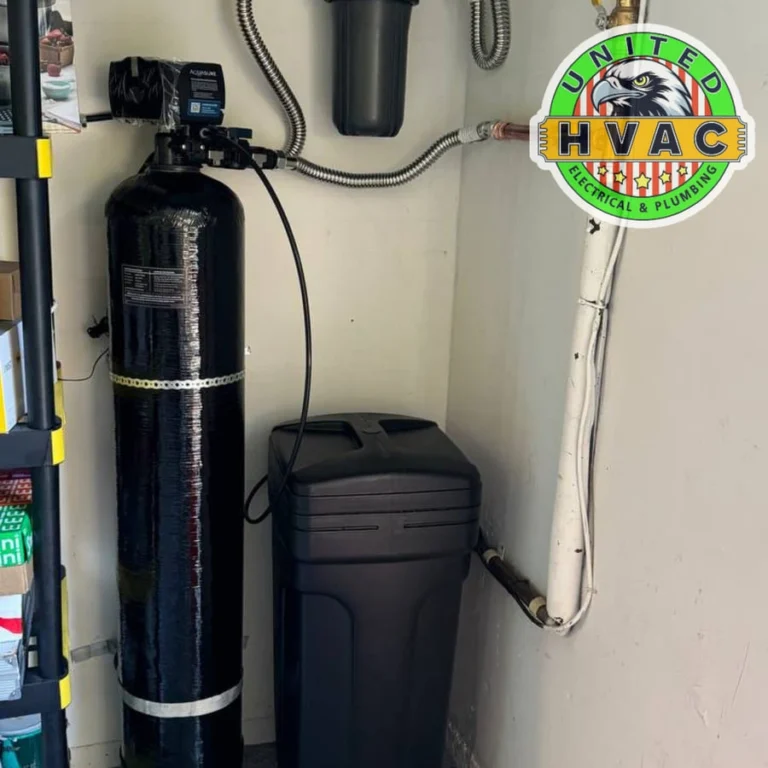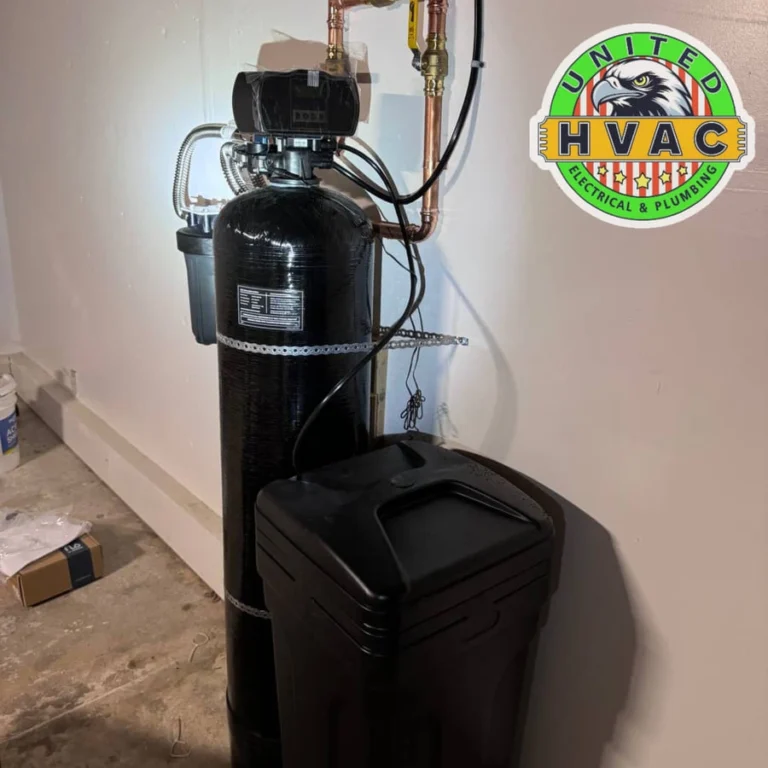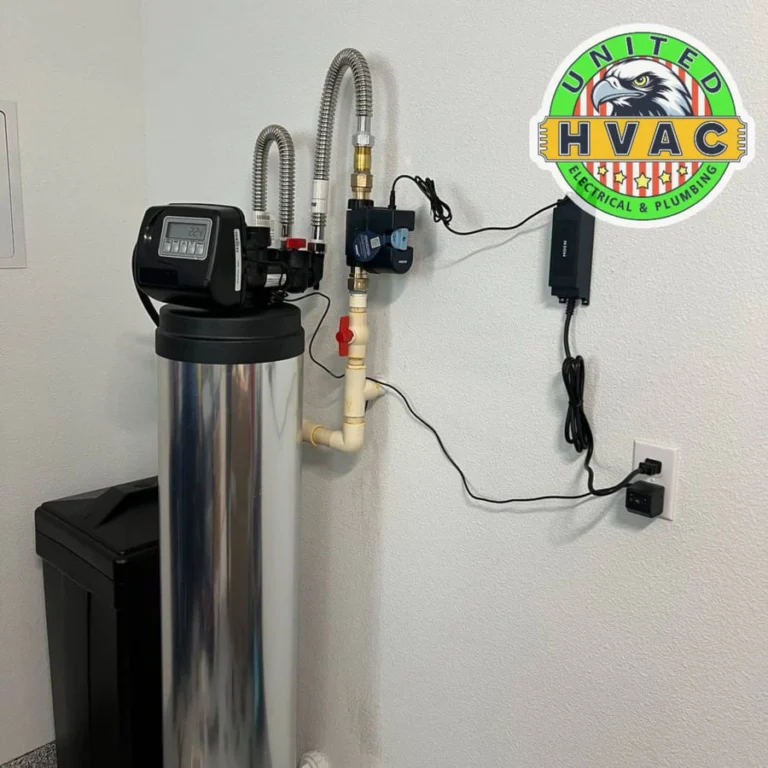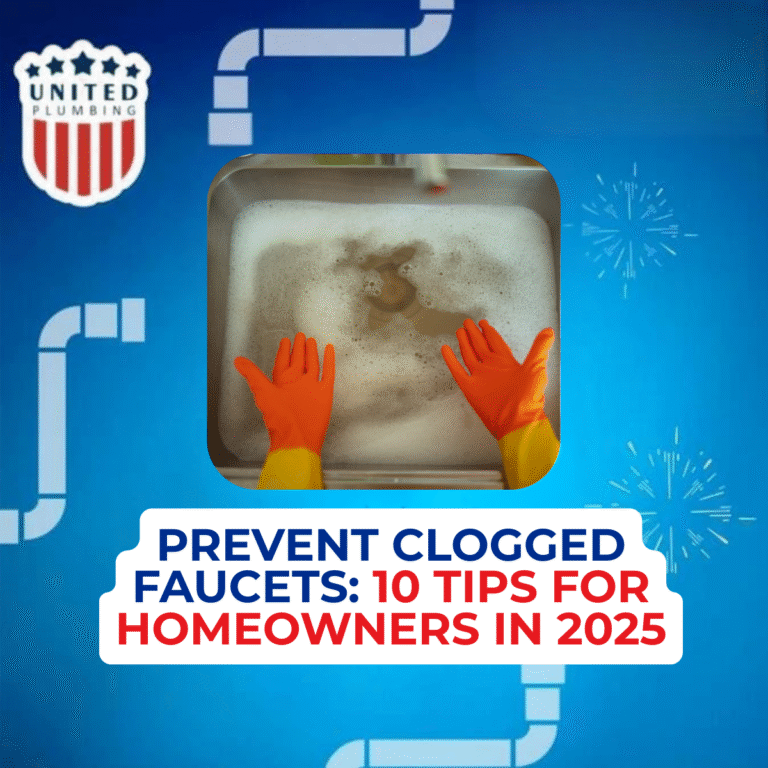FIVE-STAR TEAM WARRANTY &
SAME-DAY SERVICE
Reverse Osmosis Water Filter: What It Is and How It Works
Are you concerned about the quality of the water you drink?
A reverse osmosis water filter system may be the solution you’re seeking. Reverse osmosis water filter technology is becoming more popular among homeowners looking for cleaner, better-tasting water. Whether you’re looking for a little under-sink unit or a whole-house reverse osmosis water filter, learning how they function will help you make an informed purchase. The finest reverse osmosis water filter for your home is determined by various criteria, including your unique water quality concerns, budget, and installation preferences.
What Is a Reverse Osmosis Water Filtration System?
A reverse osmosis water filter system uses modern water purification technology to remove pollutants from water by passing it through a semipermeable membrane. Unlike conventional carbon filters, which only enhance taste and odor, reverse osmosis filter water systems remove a far wider variety of impurities, including dissolved solids, heavy metals, chlorine, and some bacteria and viruses.
Reverse osmosis technology, originally developed for seawater desalination, has been converted for residential use, providing homeowners with cleaned water directly from their taps. These systems can be installed in a variety of configurations, ranging from point-of-use systems that treat water at a single tap to complete whole-house solutions.

How Do Reverse Osmosis Water Filters Work?
To understand reverse osmosis water filter technology, first consider natural osmosis. In nature, water molecules naturally flow from less concentrated to more concentrated solutions via a semipermeable membrane in order to achieve equilibrium.
Reverse osmosis, as the name implies, reverses the natural process:
- Pressure application: The mechanism applies pressure to the concentrated water (your tap water).
- Pressure drives water molecules across a semipermeable membrane.
- Contaminant rejection: As water passes through, the membrane traps bigger molecules such as dissolved minerals, bacteria, and other pollutants.
- Purified result: Highly filtered water with much lower contamination levels.
This procedure helps the reverse osmosis water filter by producing incredibly clean water, which typically removes 95–99% of dissolved salts, bacteria, and dissolved organic components.
Key components of a reverse osmosis filter
Understanding the components of a reverse osmosis water filtration system allows you to understand its capabilities.
- Pre-filter stage: Prior to reaching the membrane, water goes through pre-filters that remove bigger particles, chlorine, and sediment. This stage protects and prolongs the life of the more expensive membrane.
- The reverse osmosis membrane is the heart of the system, comprised of thin-film composite materials that allow water molecules to flow while inhibiting impurities.
- Post-filter stage: After passing through the membrane, water is frequently subjected to a last carbon filtering to improve taste and remove residual smells.
- Most under-sink systems incorporate a storage tank since the filtration process is slow. This guarantees that purified water is ready when you turn on the tap.
- Drain connection: The system requires a connection to drain the concentrated waste water (brine) containing the filtered-out pollutants.
- Most reverse osmosis water filter home setups have a dedicated faucet for distributing filtered water that is distinct from the main sink faucet.
- The automatic shut-off valve prevents water waste by stopping production when the storage tank is full.
Reverse Osmosis Water Filter Advantages for Homeowners
Investing in a reverse osmosis water filter system has various benefits beyond simple filtering.
Improved taste and water quality
One of the most obvious benefits of a reverse osmosis water filter is improved water taste and clarity.
- Contaminant removal: The system eliminates chlorine, fluoride, lead, arsenic, nitrates, sulfates, and a variety of other compounds that can have an impact on flavor and safety.
- Crystal clear appearance: The filtration process removes minute particles that cause water to seem hazy.
- Odor elimination: The carbon filtering stages remove undesirable odors that may be present in tap water.
- Improved cooking results: Many homeowners remark that food and beverages made with reverse osmosis water taste significantly better.
Many customers describe reverse osmosis filtered water as having a “clean” or “pure” flavor, comparable to high-quality bottled water but without the plastic waste and continuing costs.
Cost-effective and environmentally friendly
While the initial expenditure in a reverse osmosis water filtration system may appear large, the long-term economics are sound:
- Reduced bottled water expenses: Families that spend $20–40 per week on bottled water might return their investment within months.
- Lower environmental impact: By eliminating the need for single-use plastic bottles, you can dramatically reduce your household’s plastic trash.
- Modern reverse osmosis systems use significantly less electricity than conventional purification processes.
- Increased device longevity: Purified water reduces mineral accumulation in coffee makers, kettles, and other water-using equipment.
When compared to bottled water consumption, most homes found reverse osmosis to be significantly more cost-effective.

Best Use Cases for Homes and Businesses
Reverse osmosis water filtration devices are especially useful in certain situations:
- Homes with high total dissolved solids (TDS): If your water contains a high mineral concentration, reverse osmosis can significantly enhance clarity and taste.
- Areas with known water pollution issues: These systems provide piece of mind to communities concerned about lead, arsenic, or other contaminants.
- Businesses where water quality influences products: Coffee shops, restaurants, and aquarium stores frequently use reverse osmosis water to ensure constant quality.
- Households with immunocompromised members: An extra layer of protection against dangerous waterborne infections can be beneficial for susceptible people.
- Homes with water softeners: Reverse osmosis can supplement water softeners by eliminating salt introduced during the softening procedure.
Types and Features of Reverse Osmosis Water Filtration Systems
To satisfy the demands and tastes of different households, the market offers a variety of reverse osmosis water filter systems.
Under-Sink Versus Whole-House Reverse Osmosis Water Filters
When researching reverse osmosis solutions, you’ll mostly come across two major configurations:
Undersink systems:
- Point-of-use solution is typically put under the kitchen sink and connected to a dedicated faucet.
- Lower initial costs: often ranging from $200–500 + installation.
- Easier maintenance: These more accessible devices make filter replacement simpler.
- Limited capacity: Typically offers filtered water to only one faucet.
- Minimal space requirements: Only needs cabinet space beneath your sink.
Whole-house reverse osmosis water filter:
- Comprehensive coverage: delivers filtered water to every tap in your home.
- Higher capacity: Designed to meet the water needs of an entire household.
- Significant investment: Typically costs $1,500 to $5,000 including installation.
- More difficult maintenance: Typically requires professional servicing.
- area considerations: Requires specialized installation area, typically in a basement or utility room
How to Select the Best Reverse Osmosis Water Filter System.
When choosing the best reverse osmosis water filter for your home, consider the following factors:
- Water quality concerns: Begin by doing a water test to discover particular toxins in your water source. Different systems excel at eliminating certain pollutants.
- Filtration stages range from four to seven. More stages often result in more thorough filtering, but also higher expenses and maintenance requirements.
- Production capacity: Common home systems range between 50 and 100 gallons per day (GPD). Larger homes may require higher-capacity systems.
- Efficiency rating: Look for the waste-to-purified water ratio. Standard systems generate around 4 gallons of waste water for every 1 gallon of filtered water; however, more efficient models can improve this ratio.
- Tank Size: Under-sink systems normally have a tank capacity of 2–4 gallons. Consider your household’s daily filtered water requirements.
- Remineralization options: Some systems feature a remineralization stage that restores beneficial minerals to the water after filtration.
- Certification: Look for systems that have been certified by NSF International or the Water Quality Association to validate claims about contamination reduction.

When and How to Replace your Filters
Proper maintenance is required for your reverse osmosis water filtration system to perform properly.
- Pre-filters and post-filters are typically replaced every 6–12 months, depending on water quality and usage volume.
- Membrane replacement: The reverse osmosis membrane typically lasts two to five years, depending on water quality and pre-filter performance.
Signs that it is time to replace filters:
- A noticeable change in water taste or odor
- Slow water production.
- Cloudy look of filtered water.
- Unusual sounds from the system
Most manufacturers recommend replacement schedules, however your actual requirements may differ depending on your individual water conditions and usage patterns.
Reverse Osmosis Water Filter Installation and Maintenance
Can you install a reverse osmosis water filter yourself?
While mechanically inclined homeowners can do their own installation, there are various aspects to consider:
Undersink systems:
- Requires connecting to the cold water supply
- Install a drain connection.
- It may be necessary to drill a hole in your sink or countertop for the dedicated faucet.
- It takes around 2–4 hours for an experienced DIYer.
- Basic plumbing tools and materials required.
Whole-house systems:
- Significantly more sophisticated installation.
- Requires cutting into main water lines
- Frequently involves electrical connections.
- It is possible that specialist tools and plumbing skills are required.
- Generally not recommended for DIY installation.
When deciding whether to install a reverse osmosis water filter yourself, evaluate your skill level and comfort with plumbing projects. Even slight installation faults might result in leaks and property damage.
Why Hire a Professional For Installation?
Professional reverse osmosis water filter installation provides various benefits.
- Expertise and efficiency: Experienced plumbers conduct installations fast and correctly, typically in 1–2 hours for conventional under-sink systems.
- Code compliance: Professionals guarantee that installations follow local plumbing codes, which is especially crucial for whole-house systems.
- System optimization: They may tailor the system to your individual water conditions and usage habits.
- Warranty protection: Many manufacturers demand professional installation to keep their warranties valid.
- Problem prevention: Proper installation prevents water leaks, faulty drainage, and insufficient water pressure.
- Training benefit: The installer can demonstrate proper maintenance practices and answer particular queries.
Professional installation normally ranges from $150 to $300 for under-sink systems and $500 to $1,000 for whole-house reverse osmosis water filter installation, an investment that frequently pays for itself in terms of future difficulties.
Regular Maintenance Tips for Long-term Use
Maintaining your reverse osmosis water filtration system is simple, yet vital.
- Filter replacements should be done on a regular basis, according to the manufacturer’s recommendations.
- System sanitization: Most manufacturers recommend flushing the entire system with a sanitizing solution once a year to ensure cleanliness.
- Annual storage tank cleaning is recommended to prevent biofilm buildup.
- Membrane care: Keep the membrane in good condition by changing pre-filters on a regular basis.
- Monitor system performance: Keep track of water production rate, pressure, and quality to identify any problems early.
- Professional service: Consider scheduling a yearly professional inspection, especially for whole-house systems.
Most homeowners find that just 30–60 minutes of maintenance every few months keeps their system functioning smoothly for years.
Conclusion
A reverse osmosis water filtration system is one of the most thorough water purification options available for household usage. These systems offer benefits that go far beyond basic filtration, such as removing pollutants and increasing flavor, as well as environmental and economic advantages.
Whether you choose an under-sink unit for drinking water or a whole-house reverse osmosis water filter system, understanding the technology allows you to make more informed decisions about installation, maintenance, and daily use. The most suitable reverse osmosis water filter for your home is determined by your specific water quality issues, household size, and budget.
For homeowners that care about water quality, reverse osmosis provides peace of mind that is difficult to obtain with other filtration systems. Newer systems provide improved efficiency, easier maintenance, and extra functions such as remineralization or smartphone monitoring.
Are you ready to learn more about installing a reverse osmosis water filter at home? Contact United HVAC, Plumbing & Electrical to schedule a consultation with one of our water quality specialists. Our skilled staff can assist you in selecting and installing the ideal system for your needs, ensuring that you get the cleanest, best-tasting water available.
Post views: 659
FAQ
How long does a reverse osmosis filter last?
The lifespan of reverse osmosis filters varies according to their components:
- Pre- and post-filters typically last 6–12 months, depending on water quality and usage.
- Reverse osmosis membranes typically last 2–5 years with sufficient pre-filtration.
- For a decent system, the housing and components will last 10–15 years.
Regular maintenance substantially increases the lifespan of all components. Following the manufacturer’s replacement plan is the most effective way to assure peak performance and longevity. Some modern systems have monitoring mechanisms that notify you when a replacement is required based on actual water usage rather than time elapsed.
Can I set up a reverse osmosis water filter myself?
While DIY installation is possible for simple under-sink reverse osmosis systems, it requires:
- Moderate plumbing skills.
- Proper tools
- Two to four hours of time
- Comfortable with cutting water lines and drilling holes.
Whole-house reverse osmosis water filter installation is substantially more complicated and is not typically recommended as a DIY project. Professional installation assures appropriate system function, prevents leaks, protects warranty coverage, and usually includes system setup optimization for your individual water circumstances. Professional installation ($150–300 for under-sink systems) is frequently a good investment when contrasted to the possible expenditures of resolving DIY installation issues.
What are the disadvantages of reverse osmosis?
Despite its numerous advantages, reverse osmosis water purification requires some considerations:
- Water waste: Standard systems produce 3–4 gallons of waste water for every gallon of filtered water, although higher-efficiency devices improve this ratio.
- Mineral removal: The process removes beneficial minerals and pollutants
- Slow production: Filtration occurs at a somewhat slow rate, requiring storage tanks.
- Regular maintenance: Systems require consistent filter replacements and the occasional sanitization.
- Installation space: Even under-sink systems demand substantial cabinet space.
- Quality systems require a more considerable initial expenditure than conventional filtration processes.
For most families, the superior filtration capacity and long-term benefits outweigh the disadvantages, but these are significant factors to consider while making your decision.
How can you add minerals back into reverse osmosis water?
Many consumers prefer to remineralize their water because reverse osmosis eliminates both useful minerals and pollutants. Options include:
- Remineralization filters: Many modern reverse osmosis water filtration systems contain an optional remineralization stage that adds calcium, magnesium, and occasionally potassium back to the water.
- Mineral drops: You can add commercially available mineral concentrations to filtered water.
- Alkaline pitchers can add minerals and modify the pH after filtration.
- Himalayan salt: Some customers add a little pinch of mineral-rich salt to a gallon of filtered water.
- Mineral-rich foods: Increasing mineral intake through food can compensate for mineral deficiencies in drinking water.
Remineralization enhances flavor for many individuals and may provide health advantages, while scientific consensus on the role of minerals in drinking water is still evolving. If you are concerned about your mineral intake, a system with built-in remineralization is the most convenient option.
Latest posts

Coldest winter for Bay Area in 2025 And What Your HVAC System Should Actually Be Doing
If your home feels colder than usual this winter, you’re not imagining it. Bay Area home heating systems are being...

Prevent Clogged Faucets: 10 Tips for Homeowners in 2025
Clogged faucets are one of the most common service calls we handle in California homes, and the good news is that...


If you still have questions or need advice, please leave a request and we will contact you as soon as possible
Need a plumber and got no clue where to start?
(408) 539-6936Facing a plumbing issue? Get a FREE in-person estimate and quick solutions from our skilled technicians, ensuring your home runs smoothly again!
